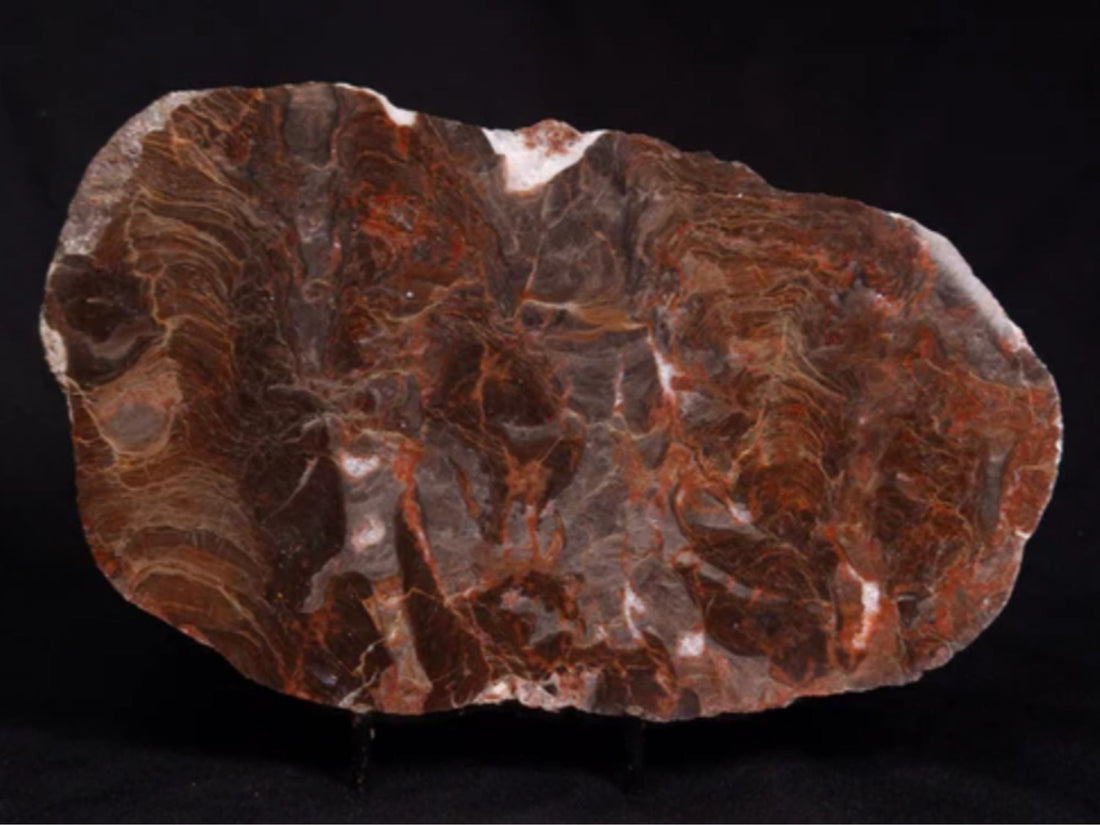
Stromatolite Fossil Record: Acaciella Australica
Share
Shop All Acaciella Australica Here
Stromatolites are laminated, biologically constructed sedimentary structures formed by the trapping, binding, and precipitation of minerals by microbial communities—primarily cyanobacteria. These fossils are among the oldest records of life on Earth, with origins stretching back over 3.4 billion years. Their presence in the geological record marks key evolutionary and environmental transitions, particularly during the Proterozoic Eon.
Acaciella australica is a distinctive stromatolite species found within the Loves Creek Member of the Bitter Springs Group, located near Alice Springs in the Northern Territory. Dated to approximately 800 million years ago (MYO), this fossil provides a rare and scientifically valuable window into microbial life during the Neoproterozoic era—a time of increasing biological complexity and atmospheric oxygenation.
Geological Context
The Bitter Springs Group is a well-studied stratigraphic unit composed primarily of dolomitic and silicified carbonates. It is renowned for its exceptional preservation of microbial structures, including stromatolites, microfossils, and other biosignatures. The Loves Creek Member, in particular, contains finely laminated stromatolitic carbonates that have undergone minimal diagenetic alteration, preserving original microbial textures and sedimentary features.
This region was part of a shallow marine platform during the Neoproterozoic, characterised by low-energy depositional environments ideal for microbial mat development. The sedimentary facies suggest periodic subtidal conditions with episodic exposure, allowing cyanobacterial communities to flourish and form extensive stromatolitic reefs.
Morphology and Composition
Acaciella australica stromatolites exhibit classic domal and columnar morphologies, with finely laminated internal structures. These laminations are the result of successive microbial mat growth cycles, each layer representing a snapshot of microbial activity and sediment interaction.
Key morphological features include:
- Concentric laminae: Alternating light and dark bands reflect changes in microbial productivity, sediment influx, and mineral precipitation.
- Vertical accretion: The stromatolites show evidence of upward growth, indicating sustained microbial colonisation over time.
- Silicification: The original carbonate structures have been replaced or infilled by silica, preserving fine details and allowing for high-resolution petrographic analysis.
- Microbially Induced Sedimentary Structures (MISS): Features such as wrinkle marks, gas domes, and mat textures are present, providing further evidence of microbial mat dynamics.
These characteristics make Acaciella australica an ideal candidate for studying Proterozoic microbial ecology and sedimentary processes.
Palaeobiological Significance
The discovery and study of Acaciella australica contribute to several key areas of palaeobiological research:
- Atmospheric oxygenation: Cyanobacteria, the primary architects of stromatolites, were instrumental in producing oxygen through photosynthesis. The presence of extensive stromatolitic reefs during the Neoproterozoic suggests active oxygen generation, potentially linked to the lead-up to the Cryogenian glaciations and the rise of multicellular life.
- Microbial evolution: These fossils represent complex, layered microbial ecosystems that predate the emergence of animals. Their structure and diversity offer insights into microbial adaptation, competition, and community organisation in ancient environments.
- Palaeoenvironmental reconstruction: Stromatolite morphology and distribution are sensitive indicators of water depth, salinity, and energy conditions. The Bitter Springs Group provides a detailed record of shallow marine conditions during a critical phase in Earth’s history.
- Biostratigraphy and correlation: The presence of Acaciella australica in the Bitter Springs Group helps correlate Proterozoic strata across Australia and globally, contributing to the broader understanding of Neoproterozoic basin development.
Australian Scientific Heritage
Australia is globally recognised for its stromatolite heritage, with both fossilised and extant examples. Living stromatolites in Shark Bay, Western Australia, continue to provide analogues for ancient forms, while fossil sites like the Bitter Springs Group offer unparalleled access to deep-time microbial ecosystems.
The Acaciella australica specimens from Alice Springs are part of this legacy. Their scientific value extends beyond academic research—they are also prized by collectors, educators, and museums for their aesthetic beauty and geological significance. These fossils serve as tangible connections to Earth’s earliest biosphere and reinforce Australia’s role in global palaeontological research.
Shop All Acaciella Australica Here
References:
- FossilEra – Polished Stromatolite (Acaciella) from Australia:
https://www.fossilera.com/fossils/7-4-polished-stromatolite-acaciella-from-australia-800-million-years - Fossils UK – Rare Proterozoic Stromatolite from Alice Springs:
https://www.fossils-uk.com/new-in-c40/fossils-c208/rare-proterozoic-precambrian-stromatolite-from-alice-springs-australia-sku-of2018-acaciella-australica-p9235